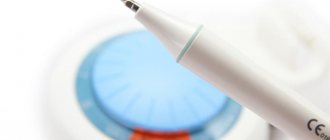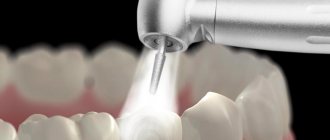Opening a dental office is not as difficult as it seems at first glance. It is important to carefully plan a budget in which equipment for the dental office will be one of the leading expense items.
A small office, unlike a specialized clinic or center, does not require large investments. If you are a novice businessman who does not have impressive financial baggage, then a dental office can be a successful start to a business. You will need less money, since this option requires a small room with a minimum set of high-quality equipment (this is due to the range of services, for example, in a clinic the list of manipulations performed by doctors is many times larger). In the future, as you gain practical experience in running a business, as well as additional funds in the form of earned profits, you will be able to open, for example, a clinic with a more expanded range of services provided.
But what you shouldn’t save on initially is the equipment with which you will treat patients. It is necessary that the equipment meets internationally accepted standards and is equipped with all first-class materials to provide high-quality dental services, regardless of the complexity of the procedure. Comfort during the provision of services and, as a result, the health of clients largely depends on the equipment.
All equipment for a dentist’s office can be divided into three groups: technological, commercial and office. Below we will look at each type in detail.
List of mandatory dental equipment for office and clinic licensing
There is a minimum list of dental equipment
for the doctor's office and other premises.
Dentist's office
It is mandatory to be equipped with the following equipment:
- A dental unit is a set of equipment designed to perform therapeutic and diagnostic tasks. This is the main component of the list of dental equipment
. Equipped with a block of instruments for the doctor (including all the necessary tips, instruments, etc.), a water and air supply system, a control unit, an assistant’s unit, the patient’s dental chair itself, etc. To open a clinic, you can choose budget options. - Compressor. Used to compress air and then supply it to dental instruments. Models vary in power.
- An aspirator is a system designed to suction blood, saliva, dust, and materials from the oral cavity. You can install centralized suction, a unit next to the dental unit, or a stand-alone device.
- The handpiece is a tool that converts the energy supplied from the installation into the corresponding movement of the working tool (bur, polishing head, etc.). The tip can be turbine, angular or straight.
- Visiograph. Allows you to take the most accurate picture of the tooth, the image is immediately displayed on the screen.
- Apex locator. Helps determine the position of the apical constriction and the length of the root canal of the tooth.
- An electroodontometer is a device that is used to check the condition of the dental pulp.
Sterilization
Dental equipment for licensing
includes installations in which tools are processed and stored. The list consists of the following items:
- An autoclave is a steam sterilizer. We need a class “B” device.
- A device that allows you to clean and lubricate the tips.
- Medical distiller.
- Ultrasonic washing.
- Sealing device (for pre-sterilization packaging of instruments and for their storage after sterilization).
- Installation for storing tools.
- Device for disinfection of instruments.
- Sterilizer for small instruments.
- Air conditioning and humidification system.
Dental office equipment
includes instruments for medical work: probes, raspatory, retractors, etc.
Is it necessary to be a dentist?
The dental business is a good investment, but many people avoid it due to the lack of specialized education. Typically, specialists who already have experience working in public or private medical institutions go into this niche. However, even an inexperienced startuper, with appropriate theoretical training, can open a successful dental office. The main thing is the professionalism of dentists.
As for legal requirements, when opening an individual entrepreneur, a businessman must have a specialized education. When registering an LLC, medical education is not required.
equipment requirements
The main requirement for dental office equipment
— availability of a certificate and registration certificate. There are many dental products on the market that do not have the required documentation. Therefore, when purchasing, you need to be careful and double-check everything. The setup, maintenance and repair of dental equipment should also be trusted to competent specialists.
A few more requirements for the organization and equipment of a dental office
:
- If the lamps are one-sided, the chairs should be placed on the light-carrying side.
- If there is more than one chair for patients, partitions must be placed between them (they should not be transparent) with a height of at least one and a half meters.
- If the clinic has no more than 3 chairs, it is not necessary to perform sterilization. Sterilization equipment can be installed in offices.
- If gypsum work is being carried out, you need to install a gypsum catcher.
- It is necessary to install an air disinfectant that can be used in dentistry. If open irradiators are used, the switches should be located outside the office.
If you have the entire list of dental office equipment according to SanPin
, and the premises itself meets all the requirements, you have completed the first (and one of the most important) points.
Brief market analysis
Dentistry has been a leader in the ranking of commercial areas since 2010.
If you look at the ratio of public and private institutions in Moscow, you will find that budget ones account for only 4%. That is, the remaining 96% are commercial organizations. Hence the conclusion: competition in the industry is high.
However, it is not competitors who pose more obstacles to a novice businessman, but the state, which puts forward strict requirements for premises, licensing, certification, and installation of x-ray equipment.
The most sought-after specialists in the industry are surgeons and therapists. Orthodontists follow them. Generalist doctors account for 11% of demand, another 6% for pediatric specialists. Every year prosthetics becomes more popular.
According to an analysis by the Russian Ministry of Health, in 2019-2021, industry growth will be about 12% per year. Such forecasts are due to the high profitability and short payback period of dental institutions. So, in the capital the profit volume is 30%, in the provinces – 20%.
Turnkey dental equipment
As a rule, it is more convenient and faster to seek the help of specialists for the selection, delivery, commissioning, and initial setup of turnkey dental equipment
.
At the same time, the full range of work must include proper maintenance of all dental equipment and equipment.
Firstly, in dentistry, constant attention to technology is especially important, since there are a lot of mechanics and pneumatics, and many elements wear out quickly.
Secondly, without a contract for the maintenance of dental equipment, it is also not possible to obtain licensing for an office or clinic. An agreement with a service company must be concluded.
Contact us: we will answer any questions about the equipment. We will help you check the current condition. We will conduct joint remote diagnostics. Or we’ll come for a full on-site inspection.
New Procedure for providing medical care to adults for dental diseases
Let's look point by point at the Order of the Ministry of Health of Russia dated July 31, 2020 No. 786n “On approval of the Procedure for providing medical care to the adult population for dental diseases” (hereinafter referred to as the New Order) in comparison with the current Order of the Ministry of Health and Social Development of the Russian Federation dated December 7, 2011 No. 1496n “On approval of the Procedure for providing medical care to the adult population for dental diseases” (hereinafter referred to as the Old Order).
So, according to the Old Order, medical care is provided to the adult population for dental diseases of the teeth, periodontium, oral mucosa, tongue, salivary glands, jaws, face and head, including:
- carious, non-carious and other dental lesions;
- acute, chronic and specific inflammatory diseases, acute and chronic trauma, acquired defects and deformations, oncological diseases of the periodontium, oral mucosa, tongue, salivary glands, jaws, face and head;
- anomalies and defects in the development of teeth, jaws, face and head, their prerequisites and consequences.
The new order contains a similar provision, but the mention of “face and head” has disappeared from it. In principle, the parts devoted to maxillofacial surgery are excluded from the New Order, since for this area of medical activity a separate order of the Ministry of Health of Russia dated June 14, 2019 No. 422n “On approval of the Procedure for the provision of medical care in the profile of “maxillofacial surgery” is provided. Thus, from 2022, the existing duplication of regulations governing the activities of maxillofacial surgeons will be eliminated. When providing medical services in the field of maxillofacial surgery, it is the Procedure approved by Order No. 422n that will be mandatory to comply with.
The New Order also reduced the number of types of medical care:
| Old order | New order |
| Medical care for the adult population for dental diseases is provided in the form of: | |
|
|
That is, the New Order no longer provides for this type of medical care for the adult population in the “Dentistry” profile, such as emergency medical care.
Instead, the New Order contains instructions on the forms of medical care for dental diseases:
- emergency form (provided for sudden acute diseases, conditions, exacerbation of chronic diseases that pose a threat to the patient’s life);
- emergency form (provided for sudden acute diseases, conditions, exacerbation of chronic diseases, without obvious signs of a threat to the patient’s life);
- planned form (provided during preventive measures, for diseases and conditions that are not accompanied by a threat to the patient’s life, do not require emergency and urgent medical care, and delaying the provision of which for a certain time will not entail a deterioration in the patient’s condition, a threat to his life and health).
As a positive innovation, we can note the inclusion in the text of the Procedure of brief definitions of emergency and emergency forms of medical care, since in practice the distinction between these forms raises a number of questions. The New Order also contains generalized medical indications for the provision of medical care in the form of emergency and emergency medical care, which are inflammatory diseases of the oral cavity, including the oral mucosa, tongue, salivary glands of various etiologies and localizations.
Let us consider the conditions for providing medical care to the adult population for dental diseases.
In accordance with the New Order, medical care for dental diseases can be provided on an outpatient basis and in a day hospital:
| Conditions for providing medical care | Criteria |
| outpatient | in conditions that do not provide round-the-clock medical supervision and treatment |
| in a day hospital setting | in conditions that provide medical supervision and treatment during the day, but do not require round-the-clock medical supervision and treatment |
Thus, the possibility of treating dental patients in a day hospital will allow doctors to monitor patients when necessary, for example, if they are elderly people with concomitant chronic diseases.
Let's sum up the intermediate results. In accordance with the New Order, medical care for the adult population for dental diseases is provided within the following criteria:
| Type of medical care | Conditions | Forms |
| Primary health care | Outpatient | Emergency |
| Specialized | Day hospital | Urgent |
| Planned |
Features of medical care for dental diseases
Like the Old Order, the New Order contains provisions on the prevention of dental diseases. Preventive measures in both cases are carried out by medical organizations that provide medical care to the adult population for dental diseases, in the form of preventive medical examinations. However, the Old Order contains a recommendation to conduct preventive medical examinations once a year, while the New Order recommends such examinations twice as often - every six months, which is more consistent with the recommendations of the professional community.
There is still a requirement to refer the patient to an oncologist if a suspicion of cancer is detected.
Separately, the New Procedure stipulates that if, during the provision of medical care to the adult population for dental diseases, diseases (conditions) of the maxillofacial area are identified, medical care is provided to the patient in accordance with the Procedure for providing medical care to the population in the field of “maxillofacial surgery”, which additionally confirms the conclusion that the provisions relating to maxillofacial surgery have been removed from the Procedure for the provision of medical care for dental diseases. Thus, the treatment of diseases of the maxillofacial area entails the obligation to comply with the Procedure for the provision of medical care in the profile of “maxillofacial surgery” (Order of the Ministry of Health of Russia dated June 14, 2022 No. 422n).
Another important innovation in the New Order is an indication of the possibility of providing medical care using telemedicine technologies by organizing and conducting consultations and (or) participating in a council of doctors in accordance with the Procedure for organizing and providing medical care using telemedicine technologies. This procedure was approved by Order of the Ministry of Health dated November 30, 2022 No. 965n “On approval of the procedure for organizing and providing medical care using telemedicine technologies.”
Telemedicine technologies will increasingly be introduced into the activities of medical professionals in the future. The new procedure defining the rules for the provision of dental medical care to the adult population, as we can see, already allows for the possibility of providing this type of care.
Anesthetic care. An important innovation in the procedure for providing medical care for dental diseases in the adult population, which comes into force in 2022, is the requirements associated with the use of anesthesia.
Relevant references are contained in two provisions of the New Order:
- “Medical care for the adult population with dental diseases can be carried out under anesthesiological conditions in accordance with the Procedure for providing medical care to the adult population in the field of anesthesiology and resuscitation” (clause 8 of the Order).
- “The main functions of a dental day hospital are: treatment of dental diseases for medical reasons under anesthesia” (clause 8 of Appendix No. 13 to the Order).
Thus, in accordance with the New Procedure, when using anesthesia in dentistry, there is an obligation to comply with the Procedure for providing medical care to the adult population in the field of anesthesiology and resuscitation, which was approved by Order of the Ministry of Health of Russia dated November 15, 2012 No. 919n. This innovation is associated with high risks of using anesthesia, the reduction of which must be ensured by following the requirements of the relevant specialized procedure for providing medical care.
The use of the term “anesthesia care” in this form raises questions related to the following factors:
- there is no normative definition of this concept;
- in accordance with the provisions of Order of the Ministry of Health of Russia dated October 13, 2017 No. 804n “On approval of the medical nomenclature is a generalized grouping for services, including, among other things, local and topical anesthesia;
- the need for licensing activities in the field of anesthesiology and resuscitation.
Taking these factors into account, dentistry faces a risk from regulatory authorities who may interpret these provisions as the need to apply the Procedure for providing medical care to the adult population in the field of anesthesiology and resuscitation for all cases of anesthesia, including local and topical anesthesia. This certainly seems like an excessive requirement. Probably, when preparing the normative act, the mandatory application of the Procedure for the profile “anesthesiology and resuscitation” was implied specifically in cases of general anesthesia. However, the lack of a clear distinction and wording of other regulations creates the threat of incorrect and dangerous interpretation of these provisions for dental clinics.
It seems that this gap should be resolved before the New Order comes into force. At a minimum, the Ministry of Health should provide appropriate clarifications.
Clinical recommendations. In accordance with paragraph 10 of the New Order, medical care for the adult population for dental diseases is provided taking into account the standards of medical care and based on clinical recommendations. This effectively means that the use of clinical guidelines becomes mandatory.
In accordance with paragraph 2 of Article 76 of the Federal Law of November 21, 2011 No. 323-FZ “On the fundamentals of protecting the health of citizens in the Russian Federation,” clinical recommendations (treatment protocols) are developed by medical professional non-profit organizations, including taking into account the results of clinical testing, are agreed upon with the main freelance specialists of the Ministry of Health.










